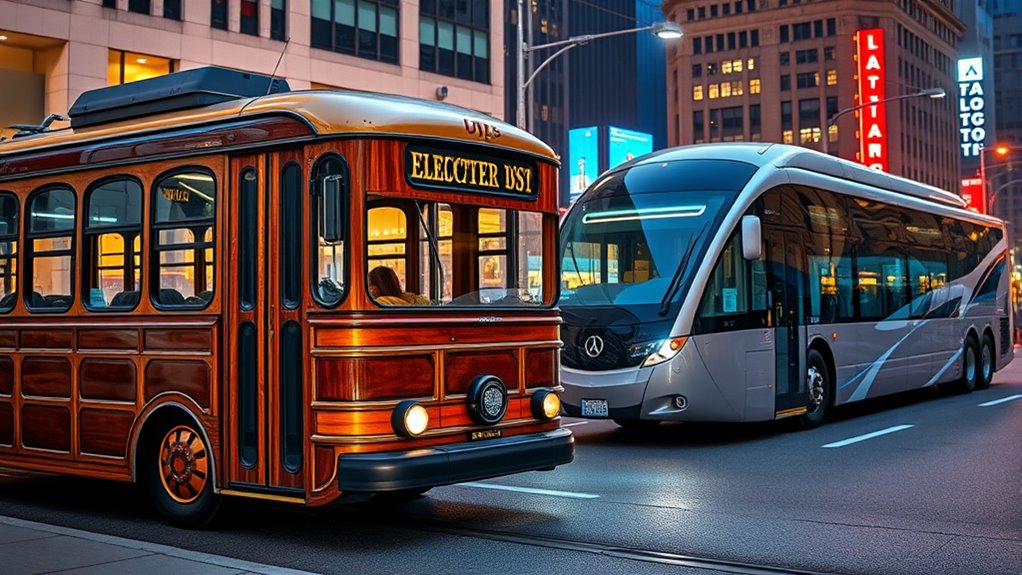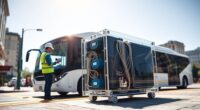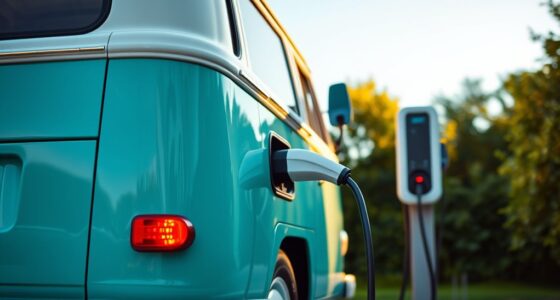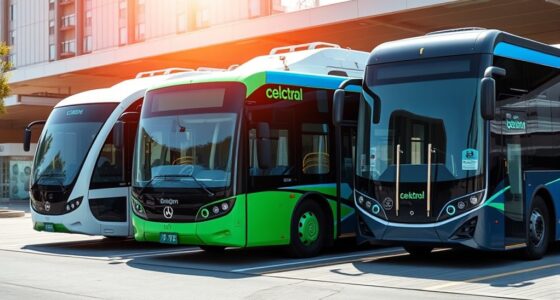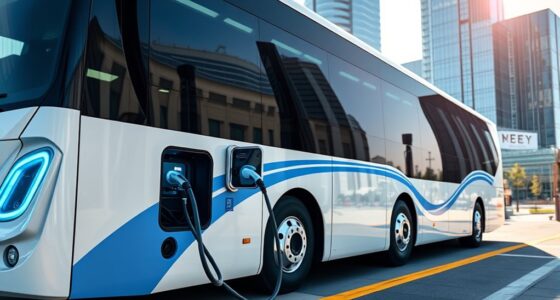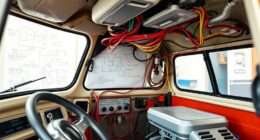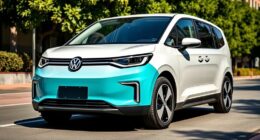Electric buses started in the late 19th century with prototypes like Kühlstein Battery bus and Morrison’s electric carriage, showcasing early electric transport potential. Throughout the 20th century, trolleybuses grew popular in Europe and North America, especially after WWII, as fuel shortages pushed their adoption. Modern electric buses, driven by advances in battery tech and environmental concerns, are now essential to urban transit plans worldwide. Continuing along this history reveals how innovation keeps shaping electric bus development.
Key Takeaways
- Electric buses first appeared in the late 19th century, demonstrating early viability for urban transit.
- The early 20th century saw expansion of trolleybus systems across Europe, with standardized overhead wiring.
- Post-World War II, electric buses gained popularity in Europe and North America, especially during fuel shortages.
- Decline occurred in the 1970s due to diesel competition, but technological advances revived electric bus development.
- Today, electric buses are integral to sustainable urban transit, driven by battery innovations and environmental concerns.

Have you ever wondered how electric buses evolved from early experiments to modern fleets? The story begins in the late 19th century, when the first electric-powered bus prototypes appeared. One of the earliest was the Kühlstein Battery bus in 1899, but electric vehicles had been experimented with earlier, like William Morrison’s 1890 electric carriage. These early efforts demonstrated that electric propulsion could work for larger vehicles, sparking interest in urban transit.
Electric buses began in the late 19th century with early prototypes like Morrison’s 1890 carriage and Kühlstein’s 1899 model.
In 1904, the World’s Fair in St. Louis showcased electric buses on the plaza, highlighting their potential. Meanwhile, in Berlin, Ernst Werner Siemens demonstrated the “Elektromote” in 1882, a trolleybus precursor that showed electric transit could be feasible. Around the same time, hybrid designs that combined rail and road transport were tested in Berlin (1899) and Paris (1900), indicating a diverse exploration of electric mobility concepts.
As the early 20th century progressed, electric bus development gained momentum. Trolleybus systems expanded across Europe, with Max Schiemann’s 1901 Bielatal system standardizing overhead wiring, making electric trolleybuses more practical. In Dresden, the Cédès-Stoll system operated between 1902 and 1904, with 18 installations demonstrating the technology’s viability.
Paris showcased a circular electric bus route at the 1900 exhibition, further promoting electric transit. By 1915, Edison had operational electric bus models, although adoption outside urban centers remained limited due to infrastructure constraints. Early electric buses mainly served densely populated areas where supporting systems like overhead wires and charging stations could be established easily.
The 1940s marked a period of commercialization, especially in Europe. Sweden’s Scania-Vabis T31 electric buses were delivered to Stockholm starting in 1940, with over 120 chassis supplied by 1951, supporting the city’s public transport. Companies like ASEA and Hägglund & Söner partnered to produce trolleybuses, which became widespread in European cities such as Berlin and London.
During this era, electric buses gained prominence in regions facing fuel shortages post-World War II, as electric transit provided an alternative to gasoline-powered vehicles. Despite these advances, the high infrastructure costs and the advent of cheaper fossil fuels led to a decline in electric bus popularity after the 1950s.
From the mid-20th century onward, electric buses became a niche. Cities like Helsinki and Vancouver retained trolleybus networks due to environmental benefits, while battery technology lagged behind. interest in electric buses was also influenced by advancements in battery technology, which improved energy storage and vehicle range. As a result, electric buses faced competition from diesel-powered vehicles, which were cheaper and easier to operate, and most trolleybus systems dismantled by the 1970s.
However, concerns about pollution and sustainability kept the idea alive. In recent decades, breakthroughs in lithium-ion batteries and growing environmental awareness reignited the push for electric buses. China led the charge, deploying over 400,000 electric buses by 2020.
Modern innovations like overnight depot charging, autonomous features, and hydrogen fuel cells are shaping today’s electric bus landscape, making them a crucial part of the future of urban transportation.
Frequently Asked Questions
What Were the Earliest Electric Bus Prototypes in the 1800S?
You’re curious about the earliest electric bus prototypes in the 1800s. Back then, electric vehicle experiments were just beginning, mainly focusing on small carriages and trams.
Although specific bus prototypes are hard to identify due to limited records, early efforts involved adapting electric motors and batteries for larger vehicles.
These prototypes laid the groundwork for later developments, even if they faced mechanical and infrastructure challenges.
How Did Electric Bus Technology Evolve During the 20TH Century?
You might think electric bus tech just vanished after the early 1900s, but it didn’t. In the 20th century, advances slowed as gasoline engines took over, driven by cheaper fuel and better infrastructure.
Yet, behind the scenes, innovations like regenerative braking and motor efficiency kept electric ideas alive. By the late century, breakthroughs in batteries and government incentives reignited electric bus development, setting the stage for today’s green transit revolution.
What Were Major Challenges Faced by Early Electric Bus Manufacturers?
You see that early electric bus manufacturers faced major hurdles, mainly high upfront costs, limited battery range, and performance issues.
You’d need to manage heavy batteries that drove up expenses and restricted passenger capacity. Charging infrastructure was scarce, causing operational delays.
Plus, battery degradation and inconsistent range made route planning tricky. These challenges slowed adoption and made investors hesitant, delaying widespread use of electric buses.
How Did Government Policies Influence Electric Bus Development Historically?
You see, government policies have considerably shaped electric bus development over time. Initially, their role was minimal, with limited support for early innovations.
Today, policies like tax breaks, subsidies, and infrastructure investments encourage adoption and technological progress. These efforts help reduce costs, improve performance, and meet environmental standards.
Which Cities First Adopted Electric Buses on a Large Scale?
You’ll find that Shenzhen was the first city to adopt an all-electric bus fleet on a large scale by the late 2010s, making it a pioneer in this shift.
Other cities, like Santiago, Bogotá, and European capitals such as London and Amsterdam, followed with significant electric bus initiatives during the 2010s.
Portland and New York also started large-scale efforts around this time, focusing on expanding their electric fleets and infrastructure.
Conclusion
As you’ve seen, the journey of electric buses is a story of innovation and resilience, echoing the timeless quest for progress. From 19th-century experiments to today’s sleek, eco-friendly models, each step pushes us closer to a cleaner future. Just as a spark ignites a flame, these vehicles ignite hope for sustainable transportation. Embrace this evolution—your choice today fuels the brighter, greener world of tomorrow.
